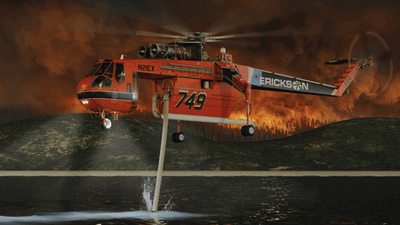Aerosystems: manufacturing and MRO services for aerial firefighting

Aging fleets need ongoing support battling a global fire season that’s increasing in both duration and intensity as a result of global warming. Erickson shares how the S-64 Air Crane® helicopter is redefining firefighting and heavy-lifting capability through innovation and upgrades.
SOLUTION
Upgrades and updates to the S-64 Air Crane® helicopter as well as service, training, and maintenance increase efficiency, durability, and use.
RESULTS
The Erickson S-64 Air Crane® helicopter combines enhanced range, fuel efficiency, and improved firefighting capability with state-of-the-art avionics and new composite main rotor blades.
OVERVIEW
Aircraft play a crucial role in combatting fire. The CDC reports that “Airplanes and helicopters are integral to the management and suppression of wildfires, often operating in high-risk, low-altitude environments.” But an aging fleet makes it more difficult for pilots to address wildfire seasons that could potentially be significantly longer than in the past. To combat this, Erickson has redesigned and improved their workhorse S-64 Air Crane® Helicopter.
CHALLENGE
Despite advances in technology, global population density means the age-old problem of fire is far from obsolete. NASA researchers explain that “Since 1880, the world has warmed by 1.9 degrees Fahrenheit (1.09 degrees Celsius), with the five warmest years on record occurring in the last five years. Since the 1980s, the wildfire season has lengthened across a quarter of the world’s vegetated surface, and in some places like California, fire has become nearly a year-round risk.”
This risk is being tackled by dedicated firefighters on the ground and skilled aviators in the air. Aircraft updates, upgrades, and integrated options can make their job easier in what are often unpredictable conditions, long hours, and uncertain situations.
SOLUTIONS IN THE AIR
Erickson upgraded the S-64 Air Crane® helicopter to include new composite main rotor blade and Next Gen Automatic Flight Control System (AFCS). Its power, technology, and efficiency lead the Government of South Korea to purchase their first S-64 Air Crane® helicopter in 2001, officially making the Korea Forest Service (KFS) the first foreign government to purchase S-64 helicopters from Erickson. Due to their success with the aircraft, KFS continues to modify and upgrade its fleet with the addition of K7 in November 2019 and K8 in December of 2019. In 2020, KFS purchased K9, adding yet another S-64 to their fleet, bringing their total operational aircraft to seven S-64 Air Crane® helicopters in South Korea. Recent upgrades include Next-Gen AFCS, firefighting tank, pond snorkel, sea snorkel, foam cannon, glass cockpit with Night Vision Goggle (NVG) capability, and composite main rotor blades. This main blade’s new design improves lift capability up to a 25,000-pound maximum gross weight in challenging and otherwise weight and performance limiting environments. The new blade design consists of a composite spar with a composite skin covering the spar and a Nomex honeycomb core forming an advanced airfoil with aft swept blade tip. The blade for the S-64 Air Crane® helicopter has an un-ballasted fully balanced configuration. Utilizing the existing main rotor hub configuration to include the bearing and spindle, a new titanium sleeve installed on the composite main rotor blade provides the interface between blade and hub. As the program progresses, Erickson expects to retrofit aircraft worldwide as the legacy blades reach their service life limit.
SOLUTIONS IN THE COCKPIT
Inside the S-64 Air Crane® helicopter, avionics have been re-designed and updated. Cockpit displays for primary flight information and engine monitoring are now glass and present information which is clearly visible from either pilot station thanks to centralized instrument panel placement for both primary instruments and emergency backups. To integrate this new technology, Erickson engineering created or revised over 130 wiring and installation diagrams. With aging, often obsolete analog instrumentation removed, Erickson Engineering and Manufacturing teams also fit new wire harnesses and wiring, modify for NVG capability, and install the new glass cockpit and Flight Management Systems. They also provide supporting system upgrades and configuring changes. “We could have hobbled along with the existing cockpit, but we wanted to provide customers with what they expect to see in a modern aircraft while addressing obsolescence” explains Billy Johnson, Senior Engineering Director of Aerosystems.
SOLUTIONS BEHIND THE SCENES
Qualification and operational testing of the upgraded aircraft and systems include complete system/sub-system functional and EMI testing, aerodynamic/structural analysis of antennae and their mounting locations and dynamic and static testing of the composite rotor blades on a test bed with the exact rotor head configuration and government and industry partner test facilities to complete certification fatigue testing. The certification fatigue test establishes the retirement life based on 14 CFR 29.571 (b)(1) requirements. Erickson is a leading global provider of aviation services specializing in defense and national security, manufacturing, Maintenance Repair and Overhaul (MRO), and Civil services. Erickson Manufacturing and MRO services include manufacturing the S-64 Air Crane® helicopter as the original equipment manufacturer (OEM) as well as manufacturing key aerospace parts for aerospace OEMs. Commercial aerial services include the operation of 20 Erickson owned and operated S-64 Air Crane® helicopters to perform firefighting, powerline construction, timber harvesting, HVAC, and specialized heavy-lift for oil and gas. Founded in 1971, Erickson is headquartered in Portland, Oregon, USA, and maintains operations in North America, South America, Europe, the Middle East, Africa, Asia Pacific, and Australia.




